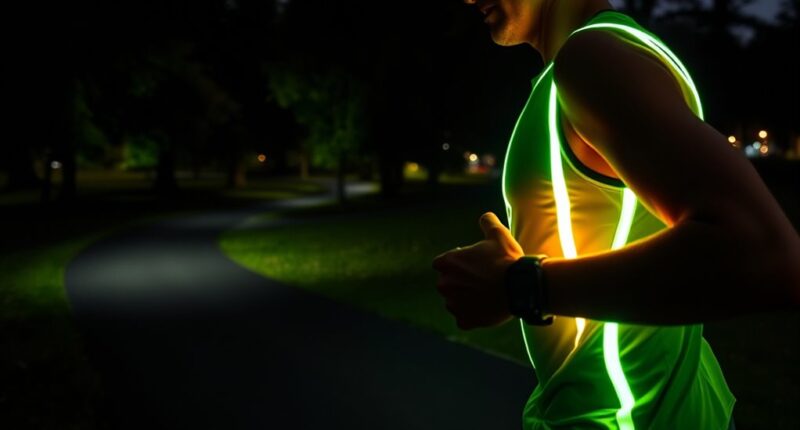For safe night running, choose well-lit, familiar routes with plenty of lighting and minimal hazards. Use GPS apps to customize your path, avoiding dark or busy streets, and share your location with trusted contacts. Wear reflective gear and bright clothing to stay visible, and carry safety essentials like a phone, flashlight, and a small first aid kit. Stay alert to your surroundings and connect with local safety networks—discover more tips to keep your runs secure.
Key Takeaways
- Prioritize well-lit, familiar routes with multiple access points and avoid isolated or poorly lit areas.
- Use GPS and navigation apps to customize routes, share real-time location, and avoid hazards.
- Wear reflective gear and bright clothing, and carry flashlights or LED bands for enhanced visibility.
- Keep your phone accessible, fully charged, and carry safety items like a small first aid kit and emergency contacts.
- Join local running groups or safety networks, and share your route and schedule with trusted contacts for added security.
Choosing Well-Lit and Safe Running Routes

When running at night, choosing routes that are well-lit and safe is essential. Look for streets with ample lighting options, such as streetlights or well-lit parks, to increase visibility and reduce risks. Well-illuminated paths help you see potential hazards like uneven pavement or obstacles, keeping you safer. Additionally, wear reflective accessories—like vests, armbands, or shoes—that bounce light back to drivers and others nearby. These accessories make you more visible from a distance, especially in poorly lit areas. Avoid isolated or poorly lit routes, even if they seem convenient. Instead, select familiar routes where lighting is consistent and security is higher. Prioritizing well-lit, safe routes ensures you can run confidently and avoid unnecessary dangers during nighttime workouts. Incorporating lighting conditions considerations into your gear, such as reflective clothing with high-visibility colors, can further enhance your safety. Being aware of bad lemon juice signs can help you avoid unpleasant surprises if you encounter food or beverages during your run or post-run recovery. Staying informed about anime movies and other entertainment options can also provide motivation and relaxation after your run.
Planning Your Path for Minimal Risks
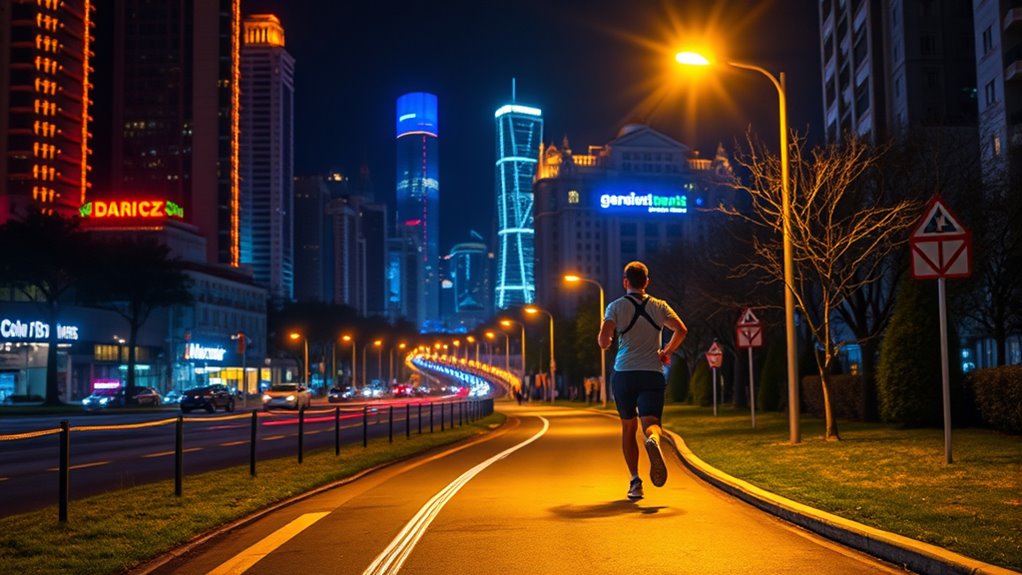
Planning your night run, choose well-lit routes to stay visible and safe. Avoid isolated areas that could pose hidden risks, and identify safe access points along your path. This careful planning helps you minimize dangers and enjoy a confident, secure run. Incorporating diverse route options can further enhance your safety by providing alternative paths in case of emergencies. Utilizing a world clock tool can also help you coordinate runs during daylight hours or ensure proper timing if running across different time zones. Additionally, reviewing local safety guidelines can provide valuable insights into specific hazards to watch for in your area.
Choose Well-Lit Routes
Choosing well-lit routes is essential for safe night running because good lighting helps you see potential hazards and makes you more visible to others. When planning your route, consider lighting options like streetlights, well-lit sidewalks, and illuminated parks. These areas reduce the risk of tripping or encountering unexpected obstacles. Additionally, wearing reflective accessories such as vests, armbands, or shoes enhances your visibility, especially in low-light conditions. Avoid poorly lit streets or shortcuts through dark alleys. Instead, stick to familiar paths with consistent lighting, so you can focus on your run without constantly checking your surroundings. Well-lit routes create a safer environment, giving you confidence and peace of mind during your night runs. Incorporating good lighting and natural elements like trees and open space can further enhance your safety and comfort. Ensuring your route has adequate visibility is crucial for early detection of obstacles and maintaining your awareness throughout the run. Using a security system or smart lighting at home can also provide added safety when returning from your run late at night.
Avoid Isolated Areas
To minimize your risks during night runs, steer clear of isolated areas where help or witnesses are scarce. Urban hazards like deserted streets, alleys, or parks can increase your vulnerability. These areas often lack proper lighting and foot traffic, making it easier for accidents or confrontations to occur. Prioritizing routes with busy sidewalks, populated neighborhoods, and well-maintained paths enhances your personal safety. Staying in areas with visible activity not only reduces chances of injury or crime but also guarantees you’re more likely to get assistance if needed. Trust your instincts—if a route feels unsafe or too remote, find an alternative. Keeping to well-traveled, populated routes helps you stay alert and safe during your night runs.
Map Safe Access Points
Planning your running route with carefully mapped safe access points helps you stay in control of your surroundings. Identify trail markers and access points along your route to guarantee quick entry and exit if needed. Map out well-lit access points near busy streets or populated areas, so you’re never far from help. Use trail markers to confirm you’re on the right path, reducing the risk of getting lost or veering into unsafe areas. Prioritize routes that have multiple access points, allowing flexibility if you need to change your path or seek assistance. By planning your route with these safe access points in mind, you create a framework that keeps you alert, prepared, and safe, even during late-night runs.
Utilizing GPS and Navigation Apps for Safety
Using GPS and navigation apps can boost your safety during night runs by allowing friends or family to see your real-time location. These apps also let you customize your route to avoid poorly lit or high-traffic areas. With these tools, you stay connected and adjust your path quickly if needed.
Real-Time Location Sharing
Sharing your real-time location through GPS and navigation apps can substantially boost your safety during night runs. It allows trusted contacts to monitor your whereabouts, providing an extra layer of security. By enabling location sharing, you can quickly alert your emergency contact if you encounter trouble or feel unsafe. Many apps integrate with personal safety gadgets, making it easier to notify someone instantly. Keep these benefits in mind:
- Instantly inform emergency contacts if needed
- Share your route with friends or family for added security
- Use location data to get help quickly in emergencies
- Combine with personal safety gadgets for seamless alerts
With real-time location sharing, you’re better equipped to stay safe and respond promptly to any situation, making your night runs more secure and enjoyable.
Route Customization Features
Route customization features in GPS and navigation apps allow you to tailor your night runs for maximum safety. These tools help you select routes that prioritize well-lit streets, avoid isolated areas, or steer clear of known hazards. With personalized safety features, you can set preferences such as avoiding high-traffic zones or areas with minimal visibility. Many apps let you create custom routes based on your safety needs, ensuring you stick to familiar or secure paths. Some also offer alerts when deviating from your chosen route or entering risky zones. By leveraging route customization, you gain greater control over your run, reducing potential dangers and increasing peace of mind. This targeted approach helps make your night runs safer, more comfortable, and aligned with your personal safety priorities.
Wearing Reflective Gear and Bright Clothing
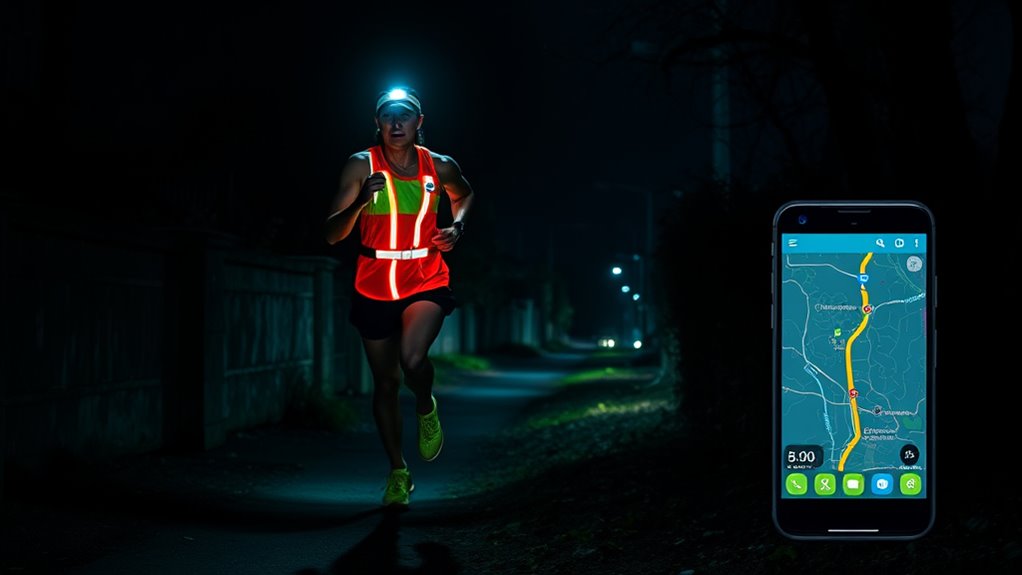
Wearing reflective gear and bright clothing is essential for staying visible to drivers during night runs. By choosing the right high visibility gear, you increase your safety and reduce the risk of accidents. Reflective clothing helps light bounce back to drivers, making you easier to spot from a distance. To maximize safety, consider these tips:
- Wear a reflective vest or jacket designed for runners
- Use bright-colored clothing like neon or fluorescent shades
- Add reflective strips to shoes and accessories
- Carry a small flashlight or LED band for extra visibility
Combining reflective clothing with bright apparel ensures you’re seen from all angles. Remember, visibility is your first line of defense when running after dark, so prioritize high visibility gear every time.
Carrying Essential Safety Equipment
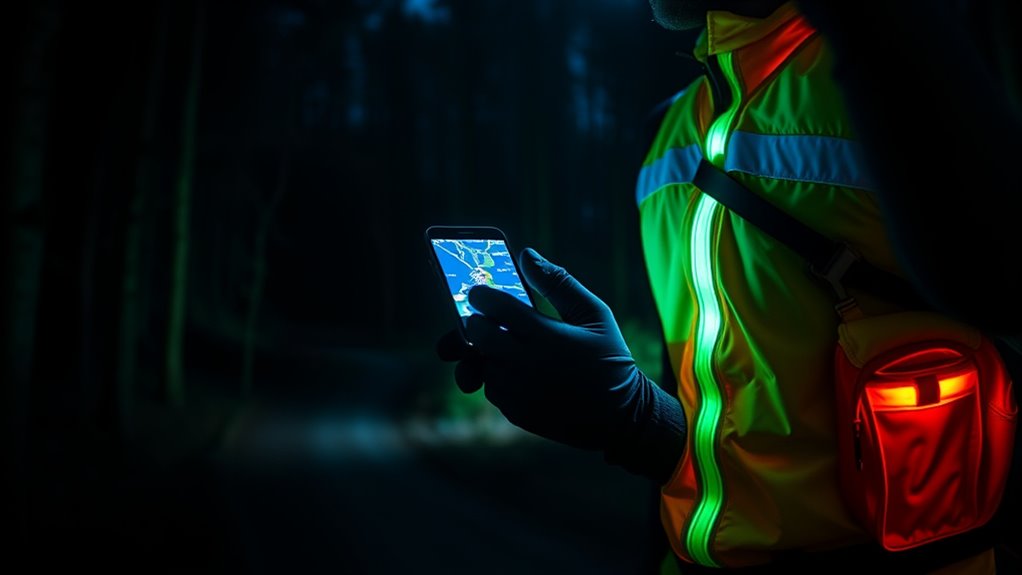
Carrying the right safety equipment can make all the difference if you encounter an emergency or unexpected situation during a night run. Always have your emergency contact information easily accessible, such as in a phone wallet or on a wearable device. A compact first aid kit is indispensable for treating minor injuries like cuts or scrapes on the spot. Consider including items like bandages, antiseptic wipes, and pain relievers. Reflective gear and a small flashlight or headlamp are also vital for visibility and signaling for help. Keep these items in a lightweight, easily accessible bag or pocket, so you’re prepared without hindering your pace. Being equipped guarantees you can respond swiftly to unforeseen events, enhancing your safety during low-light hours.
Staying Aware of Your Surroundings
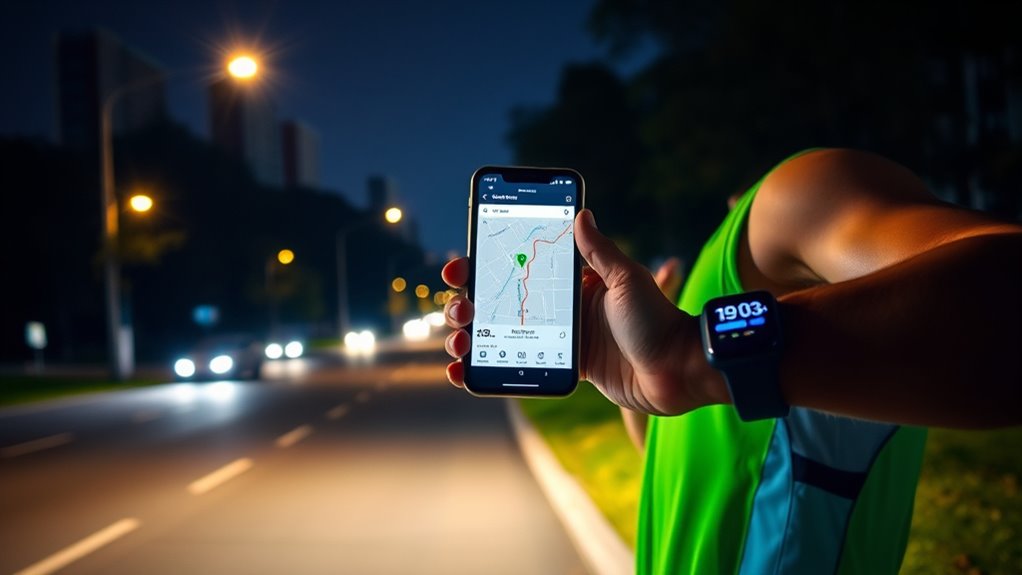
To stay safe during night runs, you need to stay alert and attentive to your surroundings at all times. Lighting conditions can change quickly, so it’s essential to adapt your awareness accordingly. Pay attention to any unusual activity or obstacles along your route. Enhance your situational awareness by scanning ahead and listening carefully for sounds that may indicate hazards.
Stay alert and adapt your awareness to changing lighting conditions for a safer night run.
To help you stay focused, consider these tips:
- Use a headlamp or bright running light for clear visibility
- Keep your phone accessible for quick alerts or emergencies
- Avoid distractions like loud music that can impair your perception
- Run in well-lit areas whenever possible
Remaining vigilant helps you react swiftly to potential dangers and ensures a safer night run.
Connecting With Running Communities and Safety Networks
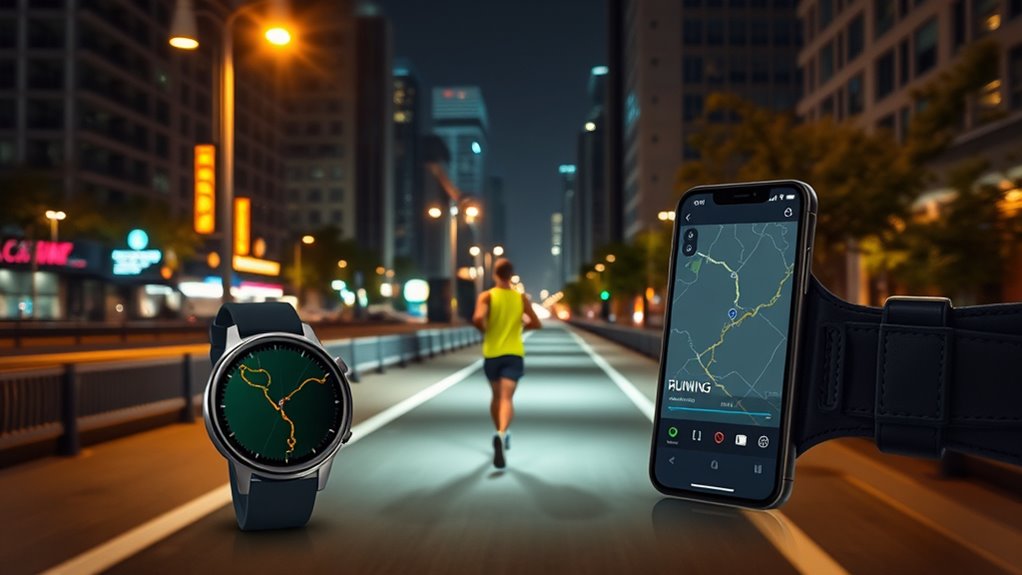
Connecting with running communities and safety networks can substantially enhance your night running safety. Joining community groups, whether local clubs or online forums, provides you with valuable resources, advice, and support. These groups often organize group runs, which are safer and more enjoyable. Safety networks, such as emergency contact apps or local watch programs, enable quick assistance if needed. Sharing your route and schedule with trusted friends or fellow runners creates an additional layer of security. Many communities also have dedicated safety initiatives, like neighborhood watch programs or running patrols, that help monitor areas during night hours. By engaging with these groups and networks, you not only gain practical safety tips but also foster connections that help you feel more confident and protected while running after dark.
Tips for Emergency Preparedness During Night Runs
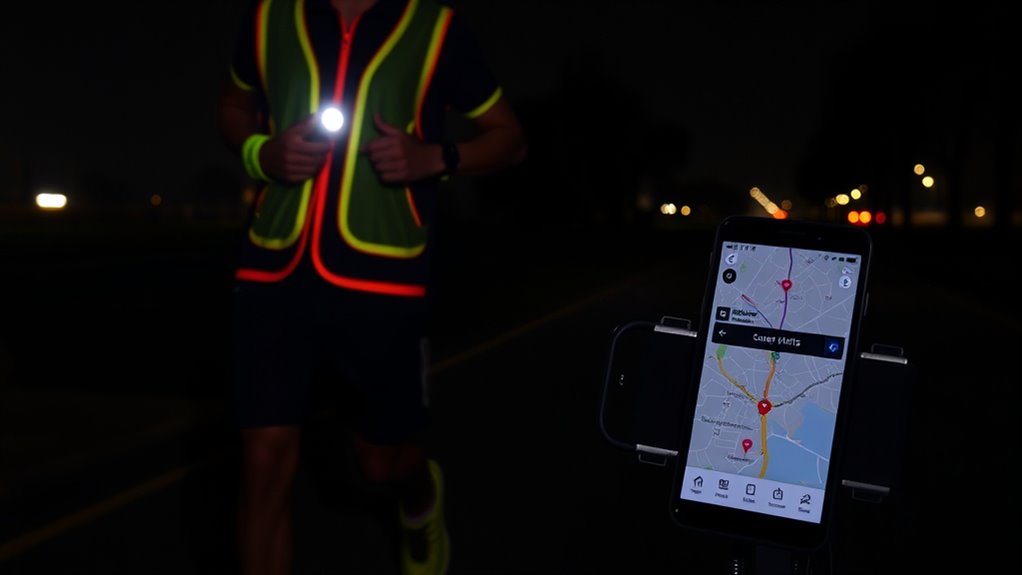
Being prepared for emergencies during night runs can make an essential difference in ensuring your safety. To stay ready, familiarize yourself with emergency contact protocols before heading out. Carry a fully charged phone and, if possible, a portable charger. Practice basic first aid preparedness so you can address minor injuries quickly.
Being prepared with emergency plans and gear ensures safety during night runs.
Consider these tips:
- Share your route and expected return time with someone you trust
- Keep a small first aid kit accessible
- Use reflective gear and lights to stay visible
- Have a plan for quick access to emergency services if needed
Frequently Asked Questions
How Can I Identify the Safest Routes for Night Running Locally?
To identify the safest routes for night running locally, start by researching well-lit areas with good lighting safety. Avoid routes with terrain hazards like uneven sidewalks or loose gravel. Check local maps or community forums for popular, maintained paths. Use your instincts and local knowledge to steer clear of isolated spots. Planning your route ahead of time helps you stay visible, safe, and confident during your night runs.
What Are the Best Apps for Real-Time Safety Updates During Night Runs?
Looking for the best apps for real-time safety updates during night runs? You’ll want apps that offer emergency communication and weather alerts, like Strava, Runkeeper, or Nike Run Club. These apps send instant alerts for changing weather and enable quick emergency contact. They keep you connected, cautious, and confident, ensuring your night runs stay safe and secure while you focus on your fitness. Stay alert, stay safe, and enjoy every stride!
How Should I Plan for Unexpected Emergencies While Running at Night?
When running at night, you should prioritize emergency preparedness and visibility enhancement. Carry a fully charged phone, a whistle, and a small first aid kit. Share your route with a friend, and consider wearing reflective gear or using headlamps to boost visibility. Always have a plan for unexpected emergencies, like knowing nearby safe spots or having quick access to help. Staying alert and prepared keeps your night runs safe and enjoyable.
What Safety Gear Is Most Effective for Different Weather Conditions?
When running at night in various weather conditions, you should prioritize safety gear like reflective clothing to stay visible. In rainy or snowy weather, wear weather-resistant gear to keep dry and warm, preventing discomfort or hypothermia. For windy or cold nights, layered clothing with reflective accents helps you stay safe and comfortable. Always choose gear suited to the forecast, ensuring you’re visible, protected, and ready for any weather changes.
How Can I Connect With Local Running Groups for Night Safety Support?
To connect with local running groups for night safety, start by engaging in community events or joining online forums. Use social media networking platforms like Facebook or Meetup to find groups that run at night. Reach out directly, share your interests, and inquire about upcoming runs. Community engagement helps you build connections, gain safety support, and stay motivated while running at night. Remember, running with others increases safety and makes the experience more enjoyable.
Conclusion
By following these safety tips, you’re better prepared for a secure night run. But what if an unexpected situation arises? Will you have the right tools, awareness, or backup? Stay vigilant, trust your instincts, and keep your safety gear close. Nights can be unpredictable—are you truly ready to face what’s lurking in the dark? Remember, a safe night run isn’t just about planning; it’s about staying alert until you reach home safe and sound.
